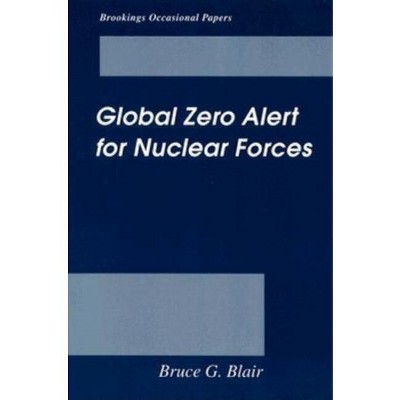$27.00 when purchased online
Target Online store #3991
About this item
Highlights
- During the past twenty-five years, U.S. strategists have argued that avoiding nuclear war depends on deterring a Soviet first strike by ensuring that U.S. forces could survive a surprise attack in numbers sufficient to inflict unacceptable damage in retaliation.
- Author(s): Bruce Blair
- 356 Pages
- Technology, Military Science
Description
About the Book
During the past twenty-five years, U.S. strategists have argued that avoiding nuclear war depends on deterring a Soviet first strike by ensuring that U.S. forces could survive a surprise attack in numbers sufficient to inflict unacceptable damage in retaliation. U.S. mili...Book Synopsis
During the past twenty-five years, U.S. strategists have argued that avoiding nuclear war depends on deterring a Soviet first strike by ensuring that U.S. forces could survive a surprise attack in numbers sufficient to inflict unacceptable damage in retaliation. U.S. military and political leaders have thus emphasized acquiring more powerful and accurate weaponry and providing better protection for it, while defense analysts have focused on assessing the relative strength and survivability of U.S. and Soviet forces. In the process neither has given sufficient attention to the vulnerability of the U.S. command, control, and communications system that would coordinate warning of an attack in progress and the response to it. In this study Bruce G. Blair examines accepted assumptions about mutual deterrence, force strength, and survivability, and concludes that the vulnerability of command, control, and communications not only precludes an effective retaliatory strike but also invites a preemptive Soviet first strike. After summarizing the assumptions and evaluative methodology behind mainstream strategic theory, the study describes the current decentralized command and control system that, under conditions of surprise attack, could be unable to communicate with decisionmakers or with units responsible for executing the decisions. Blair traces in detail the development of the system over three decades; the attempts to improve it through the use of procedural guidelines, alternative and redundant communications channels, and survival tactics; and the continuing vulnerabilities from improved Soviet weapons and the environmental forces engendered by massive nuclear detonations. Blair also analyzes the probable effects of proposals by the Reagan administration to strengthen command, control, and communications systems and provides recommendations for further strengthening and for altering related policies, deployments, and strategies to improve the stability of deterrence.From the Back Cover
During the past twenty-five years, U.S. strategists have argued that avoiding nuclear war depends on deterring a Soviet first strike by ensuring that U.S. forces could survive a surprise attack in numbers sufficient to inflict unacceptable damage in retaliation. U.S. military and political leaders have thus emphasized acquiring more powerful and accurate weaponry and providing better protection for it.Dimensions (Overall): 9.04 Inches (H) x 6.12 Inches (W) x .98 Inches (D)
Weight: 1.1 Pounds
Suggested Age: 22 Years and Up
Number of Pages: 356
Genre: Technology
Sub-Genre: Military Science
Publisher: Brookings Institution Press
Format: Paperback
Author: Bruce Blair
Language: English
Street Date: May 1, 1985
TCIN: 1004109583
UPC: 9780815709817
Item Number (DPCI): 247-21-1073
Origin: Made in the USA or Imported
Shipping details
Estimated ship dimensions: 0.98 inches length x 6.12 inches width x 9.04 inches height
Estimated ship weight: 1.1 pounds
We regret that this item cannot be shipped to PO Boxes.
This item cannot be shipped to the following locations: American Samoa (see also separate entry under AS), Guam (see also separate entry under GU), Northern Mariana Islands, Puerto Rico (see also separate entry under PR), United States Minor Outlying Islands, Virgin Islands, U.S., APO/FPO
Return details
This item can be returned to any Target store or Target.com.
This item must be returned within 90 days of the date it was purchased in store, shipped, delivered by a Shipt shopper, or made ready for pickup.
See the return policy for complete information.












